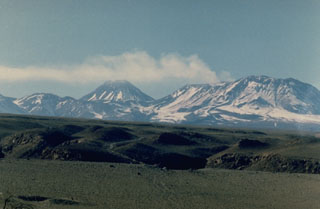Report on Lascar (Chile) — 26 January-1 February 2022
Smithsonian Institution / US Geological Survey
Weekly Volcanic Activity Report, 26 January-1 February 2022
Managing Editor: Sally Sennert.
Please cite this report as:
Global Volcanism Program, 2022. Report on Lascar (Chile) (Sennert, S, ed.). Weekly Volcanic Activity Report, 26 January-1 February 2022. Smithsonian Institution and US Geological Survey.
Lascar
Chile
23.37°S, 67.73°W; summit elev. 5592 m
All times are local (unless otherwise noted)
SERNAGEOMIN reported minor increases in surficial activity at Láscar. Nighttime incandescence from the crater began to be visible at least since 11 January. A total of 14 thermal anomalies were identified in satellite data during 13-28 January; the intensity of the anomalies increased on 17 January and peaked on 22 January. Emissions of gas and steam were more frequent and robust as compared to previous months, with the highest plume rising over 1 km above the crater rim on 22 January. Sulfur dioxide emissions were identified in satellite data on 8 and 17 January; instruments at EMU station, 6 km ESE, recorded increased emission rates during 17-19 January with a peak average of 1,787 tons per day on 18 January. Seismicity was at normal levels overall during 12-28 January. Low numbers and magnitudes of volcano-tectonic (VT) and long-period (LP) earthquakes were recorded by the seismic network, though 27 VT events that were low magnitude (M 1 or below) were recorded on 22 January. Satellite images acquired on 26 January showed no recent morphological changes at the crater nor deposits around the crater area. The Alert Level remained at Green (the lowest level on a four-color scale).
Geological Summary. Láscar is the most active volcano of the northern Chilean Andes. The andesitic-to-dacitic stratovolcano contains six overlapping summit craters. Prominent lava flows descend its NW flanks. An older, higher stratovolcano 5 km E, Volcán Aguas Calientes, displays a well-developed summit crater and a probable Holocene lava flow near its summit (de Silva and Francis, 1991). Láscar consists of two major edifices; activity began at the eastern volcano and then shifted to the western cone. The largest eruption took place about 26,500 years ago, and following the eruption of the Tumbres scoria flow about 9000 years ago, activity shifted back to the eastern edifice, where three overlapping craters were formed. Frequent small-to-moderate explosive eruptions have been recorded since the mid-19th century, along with periodic larger eruptions that produced ashfall hundreds of kilometers away. The largest historical eruption took place in 1993, producing pyroclastic flows to 8.5 km NW of the summit and ashfall in Buenos Aires.
Source: Servicio Nacional de Geología y Minería (SERNAGEOMIN)

